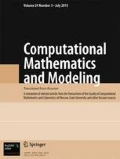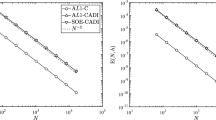This paper deals with a system of parabolic quasi-variational inequalities related to the management of energy production with mixed boundary condition. A quasi-optimal L ∞-error estimate is established using a new discrete algorithm based on a theta time scheme combined with a finite element spatial approximation. Our approach stands on a discrete L ∞-stability property with respect to the right-hand side.
Similar content being viewed by others
References
A. Bensoussan and J. L. Lions, Application des Inéquations Variationnelles en Contrôle Stochastique, Dunod, Paris (1978).
S. Boulaaras and M. Haiour, “The finite element approximation of evolutionary Hamilton–Jacobi–Bellman equation with linear source terms,” Computational and Mathematical Modeling, Accepted 2013.
S. Boulaaras and M. Haiour, “Overlapping domain decomposition methods for elliptic quasi-variational inequalities related to impulse control problem with mixed boundary conditions,” Proc. Indian Acad. Sci. (Math. Sci.), 121, 481–493 (2011).
S. Boulaaras and M. Haiour, “L ∞-asymptotic behavior for a finite element approximation in parabolic quasi-variational inequalities related to impulse control problem,” Appl. Math. Comput., 217, 6443–6450 (2011).
S. Boulaaras and M. Haiour, “The finite element approximation of evolutionary Hamilton–Jacobi-Bellman equation with nonlinear source terms,” Indag. Math. (2012), 24, Issue 1, 161–173 (2013).
M. Boulbrachene, “L ∞-Error estimate for noncoercive elliptic quasi-variational inequalities: a simple proof,” Appl. Math. E-Notes, 5, 97–102 (2005).
P. Ciarlet and P. Raviart, “Maximum principle and uniform convergence for the finite element method,” Commun. Math. Appl. Mech. Eng., 2, 1–20 (1973).
B. Perthame, “Some remarks on quasi-variational inequalities and the associated impulsive control problem,” Ann. Inst. Henri Poincare. Sect. C, 2, No. 3, 237–260 (1985).
R. Glowinski, J. L. Lions, and R. Tremolieres, Numerical Analysis of Variational Inequalities, North-Holland, Amsterdam (1981).
P. L. Lions and B. Mercier, “Approximation numérique des equations de Hamilton Jacobi Bellman,” RAIRO, Anal. Num., 14, 369–393 (1980).
Author information
Authors and Affiliations
Corresponding author
Rights and permissions
About this article
Cite this article
Boulaaras, S., le Hocine, M.A.B. & Haiour, M. The Finite Element Approximation in a System of Parabolic Quasi-Variational Inequalities Related to Management of Energy Production with Mixed Boundary Condition. Comput Math Model 25, 530–543 (2014). https://doi.org/10.1007/s10598-014-9247-9
Published:
Issue Date:
DOI: https://doi.org/10.1007/s10598-014-9247-9




